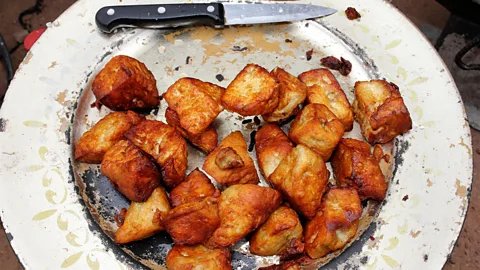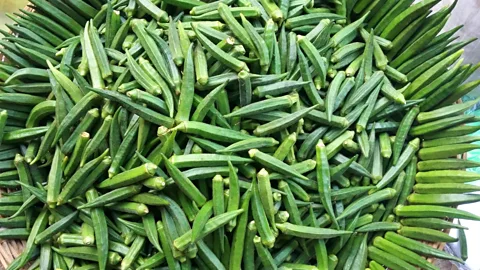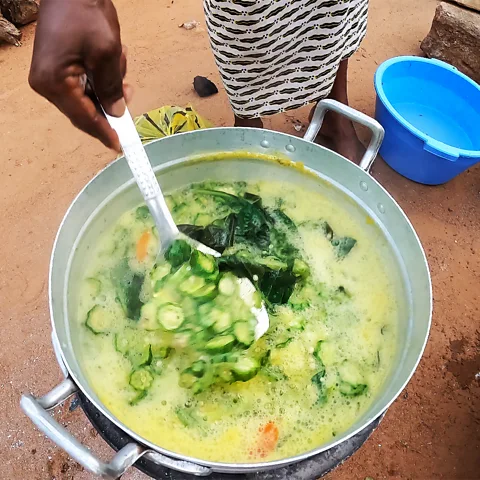Gumbo's long journey from West Africa
 john images/Getty Images
john images/Getty ImagesWest African okra stew gave rise to Louisiana gumbo along the trans-Atlantic slave route. One Louisianian travelled to Benin to discover its origins.
Fried cheese was the last thing I thought I'd see going into a traditional West African dish, but especially into an okra stew. It was just one of several ingredients that surprised me as a Louisiana-born Cajun who cut his teeth on gumbo, a pillar of southern Louisiana cuisine that's made up of seafood or meat cooked in a roux – but never with cheese.
The origins of Louisiana gumbo can be traced to West Africa, during a time when enslaved Africans brought okra (or gombo as it is known in regional tongues) with them to the Caribbean and the US South, including where I'm from, the port city of New Orleans.
But what changed from the stew that originated in the coastal cities of West Africa and ultimately became the flagship stew of Cajuns (an ethnic group of Acadian descent) and Creoles (people of mixed European, African, Caribbean and Native American ancestry)?
I wanted to see how West African okra stew was made, so I travelled to Benin. In the capital city of Cotonou, I met up with Jean-Paul Houndagnon, a mild-mannered Beninese national who invited me to Dantokpa Market, the largest open-air market in West Africa, to gather the ingredients needed for the dish. He asserted that his mother, Augustine, would happily host us in her home to cook everything, and I couldn't have been more delighted to accept such a generous invitation.
Before arriving at the food area of Dantokpa, we made our way through the market's alleyways and crevices, replete with locals selling everything from clothing, fabrics and electronics to metal pots, firewood and toys. Augustine had already created a shopping list, and Jean-Paul helped me locate the vendors that were selling them.
 Jody Ray
Jody Ray"Never pay the first price, Jody!" he instructed.
Augustine and Jean-Paul moved through the market like experts, pointing at each ingredient they knew we would need, quickly haggling with sellers then bagging up the groceries that wound up in my arms.
Finally, we crammed into a taxi back to Augustine's home, ready to prepare what I had flown across the Atlantic for – a taste of "gumbo" in the very place it originated.
The ingredients in Beninese okra stew were wildly different from those common to the traditional Cajun seafood gumbo that I'm accustomed to, which includes large peeled shrimp; white fish fillets, such as catfish, grouper, snapper or sole; crab meat; and okra. Instead, the stew we were making included elements like fried cheese, dried shrimp and cow skin for added flavour and texture.
 Sabena Jane Blackbird/Alamy
Sabena Jane Blackbird/AlamyNevertheless, as we began to cook, I started to understand how West African okra stew evolved into the deep brown gumbo everyone in Louisiana, and much of the US, knows.
Louisiana gumbo carries on the essence of West African okra stew in that it provides a bowl of well-seasoned fish and seafood, meat and vegetables encased in a thickened sauce and is served with a carbohydrate. In Louisiana, it's rice. In West Africa, it's fufu, a sticky bread made from cassava used to scoop the contents from the bowl.
Louisiana gumbo's essential ingredient
The first mention of gumbo in American cookbooks was in 1802, well after European colonisers and other settlers encountered Indigenous people. In the US South, Indigenous tribes were growing corn and sassafras, and each of these found its way into gumbo, adding both flavour and texture. Nearly every gumbo in Louisiana is made with ground sassafras, or filé powder, and most would argue it's not a real Louisiana gumbo without it.
But Louisiana's gumbo is also distinct in that it starts with a roux, a French thickening technique made by cooking a mixture of flour and butter or other fat (in gumbo's case, it's cooked to an almost chocolate colour). The introduction of the roux to Louisiana gumbo stems from the Acadians (Cajun ancestors), French colonists who were ultimately exiled from French-Canada in the mid-1700s, eventually settling in Louisiana.
According to Marcelle Bienvenu, author of Stir the Pot: A History of Cajun Cuisine, Acadian culinary traditions in Louisiana were adapted over time and were "eventually incorporated into Indigenous American as well as African American traditions".
However, as if things weren't already complicated, not all Louisiana gumbos are the same. "The major difference between Creole and Cajun food is in the type of roux used as the base for the classic sauces, stews, soups and many other savoury dishes. A typical Creole roux is made from butter and flour (as in ), while a Cajun roux is usually made with lard or oil and flour," explained Cajun chef Terri Wuerthner in an article for The Spruce Eats. She continued, "Creole gumbo has a tomato base and is more of a soup, while Cajun gumbo has a roux base and is more of a stew."
 Hemant Jain/EyeEm/Getty Images
Hemant Jain/EyeEm/Getty ImagesBack in Benin, there was no roux at all. Instead, sliced okra that was cooked down into a thick green sauce became the based to which we added mackerel, salted fish, a paste made from grinding chilli and dried shrimp, and strips of boiled cow skin, mixing in blocks of cheese that had been pan-fried in palm oil over a fire. The ultra-thickness from the okra is key as the stew is eaten by hand, using a piece of fufu as a utensil. While Louisiana gumbo also includes slices of okra, in the West African version, the okra becomes the sauce itself, enveloping each ingredient.
Cooking a traditional West African gumbo can take hours if you're going it alone. West Africans use fresh ingredients that require the fish to be gutted and filleted, cow skin to be shaved and boiled, huge portions of okra to be sliced, crab to be cleaned for their meat, and dried shrimp and chillies to be ground by hand. In the US, many gumbo ingredients can be bought ready-to-go, cutting down on the labour-intensive preparations.
In Louisiana, we claim gumbo as a symbol of what makes us different from every other state in the US. But the thing about it is that it's particularly West African. While there might be small variations between what you'll find in Ghana, Nigeria, Togo or Benin, this stew (along with fufu and jollof) binds West Africans together. West African okra stew is one of the parents of Louisiana gumbo, their connection having stretched across oceans and seas. And while attached to a brutal history, what remains is a culinary delight that continues to evolve.
 Jody Ray
Jody RayImpromptu Dantokpa market okra stew
By Augustine and Jean-Paul Houndagnon
(serves 6-8)
Ingredients
5-10 whole mackerel
10-15 crabs
two 355ml bottles of palm oil
salt
5 salted fish
1 very large bowl, or about 100 pieces of okra, plus more as needed
225-275g dried shrimp (8-10oz) dried shrimp
1 green chilli
1 red chilli
2 onions
2 tomatoes
4 large pieces cow skin, cut up into strips (optional)
10 large chunks (about 5cm x 5cm) of curded cheese
herbs and spices (such as chillies, coriander, basil or anything else you'd want to add for flavour; there is no official rule)
fufu
Method
Step 1
Remove the fish meat from the body of the fish and the crab meat from the shells. Place into a bowl to the side.
Step 2
Create a fish stock by boiling the discarded fish and crab shells in a stockpot with a one bottle of palm oil and cover with water, constantly stirring. Season with salt.
Step 3
Cut the salted fish into bite-sized pieces.
Step 4
Slice the okra.
Step 5
Grind the dried shrimp and chillies into a paste.
Step 6
Dice the onions and tomatoes.
Step 7
Shave the hairs off the cow skin (if using) and boil in water for 10 minutes. Cut into strips once softened, season generously with salt.
Step 8
Fry the cheese curds for approximately 5 minutes, until they harden and become crispy around the edges.
Step 9
Sauté the fish and crab meat for a couple of minutes, or simply add to the simmering stockpot of the fish stock. Skim the scum that rises to the surface and discard. Cook at a slight simmer for 1 hour.
Step 10
Add the okra to the pot and simmer it down until it liquifies and becomes gelatinous. To save time, you could mash the okra with a mortar and pestle before adding it to the stock. Add enough okra to turn the watery stock into a soup-like broth. (The more you add, the thicker it will become.)
Step 11
Add the second bottle of palm oil into the broth. This emulsifies with the okra and creates a creamier and less bitter sauce.
Step 12
Add the dried shrimp and chilli paste and stir. Add the onions and tomato. Add in the salted fish. Season the stew with salt to taste. Cook for another hour, or longer, until the okra has completely cooked down into a thick, green sauce.
Step 13
Add the cow skin (if using) and cheese for a final 10 minutes. If you add the cheese too early in this process, it will melt into the stew.
Step 14
Allow to cool and ladle into individual bowls. Serve with fufu.
BBC.com's World's Table "smashes the kitchen ceiling" by changing the way the world thinks about food, through the past, present and future.
---
more than three million BBC Travel fans by liking us on Facebook, or follow us on Twitter and Instagram.
If you liked this story, sign up for the weekly bbc.com features newsletter called "The Essential List". A handpicked selection of stories from BBC Future, Culture, Worklife and Travel, delivered to your inbox every Friday.
